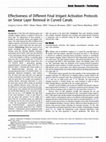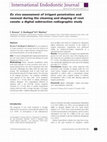Papers by François Bronnec
International Endodontic Journal, Apr 1, 2010
Bronnec F, Bouillaguet S, Machtou P. Ex vivo assessment of irrigant penetration and renewal durin... more Bronnec F, Bouillaguet S, Machtou P. Ex vivo assessment of irrigant penetration and renewal during the cleaning and shaping of root canals: a digital subtraction radiographic study.
PARIS7-Odontologie (751062104) / SudocPARIS-BIUM (751062103) / SudocSudocFranceF
Revue D Odonto Stomatologie, 2009
Contrairement aux felures coronaires qui, lorsqu'elles sont symptomatiques, donnent lieu a de... more Contrairement aux felures coronaires qui, lorsqu'elles sont symptomatiques, donnent lieu a des signes pulpaires tres caracteristiques, les fractures radiculaires n'engendrent le plus souvent qu'une symptomatologie frustre, dominee par les signes parodontaux. Si on a longtemps attribue l'origine des fractures radiculaires au traitement endodontique et a l'utilisation de tenons radiculaires, il faut reconnaitre que l'etiologie est le plus souvent multifactorielle. Elle s'explique par une diminution des proprietes mecaniques de la dent (liee au delabrement, aux modifications et au vieillissement des structures) et un exces de sollicitation (dentisterie iatrogene, facteur occlusal traumatique) qui conduisent a la rupture par fatigue.
Revue D Odonto Stomatologie, 2007
Depuis sa commercialisation, le Thermafil® a fait l'objet de critiques, concernant pour l'... more Depuis sa commercialisation, le Thermafil® a fait l'objet de critiques, concernant pour l'essentiel son manque de controle du niveau de l'obturation. Pourtant, des modifications dans la mise en oeuvre clinique de cette technique permettent d'en limiter les inconvenients et de la rendre davantage predictible. Cette technique d'obturation canalaire permet en effet d'obtenir d'excellents resultats, notamment pour l'obturation des canaux longs et courbes, dans la limite de ses indications et des lors qu'un protocole strict est suivi.

Journal of Endodontics, 2016
The present study reports the results of a randomized clinical trial comparing local intraosseous... more The present study reports the results of a randomized clinical trial comparing local intraosseous methylprednisolone injection and emergency pulpotomy in the management of acute pulpitis on efficacy, safety, and efficiency end points. After providing prior informed written consent, 94 patients consulting for acute irreversible pulpitis pain at university-affiliated teaching hospital dental clinics in Dakar, Senegal were randomly assigned to either the methylprednisolone treatment group (n = 47) or the pulpotomy treatment group (n = 47). Patients were followed up at 1 week and assessed 6 months later to evaluate the therapeutic outcome of their treatment. At day 7 the patients in the methylprednisolone group reported less intense spontaneous and percussion pain in the day 0-day 7 period than the patients in the pulpotomy group. Methylprednisolone treatment took approximately 7 minutes (4.6-9.3) less to accomplish than pulpotomy (or about half the time). No difference in the therapeutic outcome was found between the 2 treatment groups at 6 months (all credible intervals span 0). This study establishes that methylprednisolone injection for acute pulpitis is relieved by a minimally invasive pharmacologic approach more effectively than by the reference pulpotomy and conserves scarce dental resources (ie, endodontic equipment and supplies, dental surgeon's time).
Case reports in dentistry, 2015
Aim. To report on the endodontic and periodontal management of a root and alveolar process perfor... more Aim. To report on the endodontic and periodontal management of a root and alveolar process perforation in a maxillary front tooth. Summary. Perforation during access cavity preparation is an infrequent complication during endodontic therapy, leading to potential periodontal tissue breakdown. The case described the two-stage management of a massive facial root perforation requiring a connective tissue graft to correct a mucosal fenestration persisting after orthograde repair of the root defect with MTA.

Journal of Endodontics, 2010
Introduction: A final flush with chelating agents and antiseptic irrigating solutions is needed t... more Introduction: A final flush with chelating agents and antiseptic irrigating solutions is needed to remove the smear layer. The improvement of these protocols is possible by using specific delivery and agitation techniques. This study examined the effect of different final irrigation regimens and methods of activation on smear layer removal in curved canals after root canal instrumentation. Methodology: Mesial root canals of 50 extracted mandibular molars were prepared using ProTaper rotary files (Dentsply Maillefer, Ballaigues, Switzerland) and 3% NaOCl. Teeth were then allocated to two control groups and four experimental groups (n = 10) for final irrigation as follows: no-activation group (final rinse with a 27-gauge needle and 17% EDTA/3% NaOCl), manual-dynamic activation group (final rinse 17% EDTA/3% NaOCl + gutta-percha agitation), automated-dynamic activation group (final rinse 17% EDTA/3% NaOCl + RinsEndo [Dü rr Dental GmbH & Co KG, Bietigheim-Bissingen, Germany]), and sonicactivation group (final rinse 17% EDTA/3% NaOCl + Endoactivator [Advanced Endodontics, Santa Barbara, CA]). All mesial roots were split with a new approach to allow visualization of every third of the canal, particularly the apical third. The samples were prepared for scanning electron microscopic observation to assess the smear layer removal. Blind scoring was performed by two calibrated observers using a five-score scale. The differences in smear layer scores between the experimental groups were analyzed with the Kruskal-Wallis test and the Mann-Whitney U test. The level of significance was set at p = 0.05. Results: Very high levels of root canal cleanliness (#score 3) were found for each test group with activation. For the middle and apical third, the no-activation group was significantly less effective than the three other activation groups (p < 0.05). The manual-dynamic activation group (final rinse 17%EDTA/3%NaOCl + gutta-percha agitation) and the sonic-activation group (final rinse 17%EDTA/ 3%NaOCl + Endoactivator) showed significantly better smear layer removal (p < 0.05) in comparison with the other test groups in the apical third. Conclusion: Root canal cleanliness benefits from solutions activation (especially sonic activation and manual-dynamic activation) in comparison with no activation during the final irrigation regimen. (J Endod 2010;36:1361-1366

International Endodontic Journal, 2010
Bronnec F, Bouillaguet S, Machtou P.Ex vivo assessment of irrigant penetration and renewal during... more Bronnec F, Bouillaguet S, Machtou P.Ex vivo assessment of irrigant penetration and renewal during the final irrigation regimen. International Endodontic Journal.Bronnec F, Bouillaguet S, Machtou P.Ex vivo assessment of irrigant penetration and renewal during the final irrigation regimen. International Endodontic Journal.AbstractAim To assess irrigant penetration in curved canals after shaping procedures ex vivo.Methodology Thirty extracted mandibular molars with moderate to severe root canal curvature were included. A special aiming device was used to guarantee that each successive radiograph was taken with the same positioning. The mesiolingual canal of each tooth was instrumented with ProTaper rotary files. Apical third preparation was completed with an F1 instrument before additional step-back enlargement using F2 then F3 instruments. For each apical taper, the teeth were submitted successively to active irrigation (AI) then to passive irrigation (PI). AI consisted of a 0.5 mL flush of sodium diatrizoate (Hypaque 50%) immediately followed by manual mechanical activation with a gutta-percha point. PI consisted in flushing the canals with sodium hypochlorite passively delivered with a syringe. A digital radiograph was taken after each modality. The influence of needle tip design, needle tip insertion level, irrigant volume, root canal taper and solution activation was assessed by using digital subtraction radiography and measures of the depths of irrigant penetration. Comparisons were performed within an analysis of variance framework in a repeated-measures approach.Results For PI, all the four explanatory variables ‘apical taper’, ‘volume of irrigant used’, ‘corono-apical level of needle tip placement’, ‘needle tip design’ had a significant (P < 0.005) influence on outcome of irrigation penetration.Conclusions Only active irrigation allowed complete penetration and exchange of irrigating solution. For syringe irrigation alone, the level of needle tip placement in the canal was the most dominating factor.Aim To assess irrigant penetration in curved canals after shaping procedures ex vivo.Methodology Thirty extracted mandibular molars with moderate to severe root canal curvature were included. A special aiming device was used to guarantee that each successive radiograph was taken with the same positioning. The mesiolingual canal of each tooth was instrumented with ProTaper rotary files. Apical third preparation was completed with an F1 instrument before additional step-back enlargement using F2 then F3 instruments. For each apical taper, the teeth were submitted successively to active irrigation (AI) then to passive irrigation (PI). AI consisted of a 0.5 mL flush of sodium diatrizoate (Hypaque 50%) immediately followed by manual mechanical activation with a gutta-percha point. PI consisted in flushing the canals with sodium hypochlorite passively delivered with a syringe. A digital radiograph was taken after each modality. The influence of needle tip design, needle tip insertion level, irrigant volume, root canal taper and solution activation was assessed by using digital subtraction radiography and measures of the depths of irrigant penetration. Comparisons were performed within an analysis of variance framework in a repeated-measures approach.Results For PI, all the four explanatory variables ‘apical taper’, ‘volume of irrigant used’, ‘corono-apical level of needle tip placement’, ‘needle tip design’ had a significant (P < 0.005) influence on outcome of irrigation penetration.Conclusions Only active irrigation allowed complete penetration and exchange of irrigating solution. For syringe irrigation alone, the level of needle tip placement in the canal was the most dominating factor.

International Endodontic Journal, 2010
Bronnec F, Bouillaguet S, Machtou P.Ex vivo assessment of irrigant penetration and renewal during... more Bronnec F, Bouillaguet S, Machtou P.Ex vivo assessment of irrigant penetration and renewal during the cleaning and shaping of root canals: a digital subtraction radiographic study. International Endodontic Journal, 43, 275–282, 2010.Bronnec F, Bouillaguet S, Machtou P.Ex vivo assessment of irrigant penetration and renewal during the cleaning and shaping of root canals: a digital subtraction radiographic study. International Endodontic Journal, 43, 275–282, 2010.AbstractAim To assess radiographically irrigant penetration in the root canal system of curved roots during root canal shaping procedures ex vivo.Methodology Thirty extracted mandibular molar teeth with moderate to severe curvature were used. A special aiming device was used to guarantee that each successive radiograph was taken with the same positioning. The mesiolingual canal of each tooth was instrumented using the ProTaper system. For each step of the shaping procedure, two irrigation modalities were repeated in the same order. Active irrigation consisted of a 0.5-mL flush of sodium diatrizoate solution (Hypaque 50%) immediately followed by agitation with a size 08 K-file. Passive irrigation consisted of a 0.5-mL flush of sodium hypochlorite solution delivered with a syringe through a 27-gauge notched tip needle. A digital radiograph was taken after each modality and stored on computer for subsequent digital subtraction and measures of the depths of irrigant penetration. Comparisons were performed within an analysis-of-variance framework in a repeated-measures approach.Results The penetration of irrigants was significantly greater for each successive step of the shaping procedure when the two modalities were analysed separately (P < 0.001). The difference between the two modalities was statistically significant for each step of the shaping procedure (P < 0.0001).Conclusions Shaping root canals improved both penetration and exchange of irrigant inside the root canal system. Complete renewal of the solution was impossible to achieve with a conventional syringe delivery system and a limited volume of solution. Recapitulation with a K-file after flushing improved irrigant penetration.Aim To assess radiographically irrigant penetration in the root canal system of curved roots during root canal shaping procedures ex vivo.Methodology Thirty extracted mandibular molar teeth with moderate to severe curvature were used. A special aiming device was used to guarantee that each successive radiograph was taken with the same positioning. The mesiolingual canal of each tooth was instrumented using the ProTaper system. For each step of the shaping procedure, two irrigation modalities were repeated in the same order. Active irrigation consisted of a 0.5-mL flush of sodium diatrizoate solution (Hypaque 50%) immediately followed by agitation with a size 08 K-file. Passive irrigation consisted of a 0.5-mL flush of sodium hypochlorite solution delivered with a syringe through a 27-gauge notched tip needle. A digital radiograph was taken after each modality and stored on computer for subsequent digital subtraction and measures of the depths of irrigant penetration. Comparisons were performed within an analysis-of-variance framework in a repeated-measures approach.Results The penetration of irrigants was significantly greater for each successive step of the shaping procedure when the two modalities were analysed separately (P < 0.001). The difference between the two modalities was statistically significant for each step of the shaping procedure (P < 0.0001).Conclusions Shaping root canals improved both penetration and exchange of irrigant inside the root canal system. Complete renewal of the solution was impossible to achieve with a conventional syringe delivery system and a limited volume of solution. Recapitulation with a K-file after flushing improved irrigant penetration.

Journal of Endodontics, 2010
Introduction: A final flush with chelating agents and antiseptic irrigating solutions is needed t... more Introduction: A final flush with chelating agents and antiseptic irrigating solutions is needed to remove the smear layer. The improvement of these protocols is possible by using specific delivery and agitation techniques. This study examined the effect of different final irrigation regimens and methods of activation on smear layer removal in curved canals after root canal instrumentation. Methodology: Mesial root canals of 50 extracted mandibular molars were prepared using ProTaper rotary files (Dentsply Maillefer, Ballaigues, Switzerland) and 3% NaOCl. Teeth were then allocated to two control groups and four experimental groups (n = 10) for final irrigation as follows: no-activation group (final rinse with a 27-gauge needle and 17% EDTA/3% NaOCl), manual-dynamic activation group (final rinse 17% EDTA/3% NaOCl + gutta-percha agitation), automated-dynamic activation group (final rinse 17% EDTA/3% NaOCl + RinsEndo [Dü rr Dental GmbH & Co KG, Bietigheim-Bissingen, Germany]), and sonicactivation group (final rinse 17% EDTA/3% NaOCl + Endoactivator [Advanced Endodontics, Santa Barbara, CA]). All mesial roots were split with a new approach to allow visualization of every third of the canal, particularly the apical third. The samples were prepared for scanning electron microscopic observation to assess the smear layer removal. Blind scoring was performed by two calibrated observers using a five-score scale. The differences in smear layer scores between the experimental groups were analyzed with the Kruskal-Wallis test and the Mann-Whitney U test. The level of significance was set at p = 0.05. Results: Very high levels of root canal cleanliness (#score 3) were found for each test group with activation. For the middle and apical third, the no-activation group was significantly less effective than the three other activation groups (p < 0.05). The manual-dynamic activation group (final rinse 17%EDTA/3%NaOCl + gutta-percha agitation) and the sonic-activation group (final rinse 17%EDTA/ 3%NaOCl + Endoactivator) showed significantly better smear layer removal (p < 0.05) in comparison with the other test groups in the apical third. Conclusion: Root canal cleanliness benefits from solutions activation (especially sonic activation and manual-dynamic activation) in comparison with no activation during the final irrigation regimen. (J Endod 2010;36:1361-1366

International Endodontic Journal, 2010
Bronnec F, Bouillaguet S, Machtou P.Ex vivo assessment of irrigant penetration and renewal during... more Bronnec F, Bouillaguet S, Machtou P.Ex vivo assessment of irrigant penetration and renewal during the final irrigation regimen. International Endodontic Journal.Bronnec F, Bouillaguet S, Machtou P.Ex vivo assessment of irrigant penetration and renewal during the final irrigation regimen. International Endodontic Journal.AbstractAim To assess irrigant penetration in curved canals after shaping procedures ex vivo.Methodology Thirty extracted mandibular molars with moderate to severe root canal curvature were included. A special aiming device was used to guarantee that each successive radiograph was taken with the same positioning. The mesiolingual canal of each tooth was instrumented with ProTaper rotary files. Apical third preparation was completed with an F1 instrument before additional step-back enlargement using F2 then F3 instruments. For each apical taper, the teeth were submitted successively to active irrigation (AI) then to passive irrigation (PI). AI consisted of a 0.5 mL flush of sodium diatrizoate (Hypaque 50%) immediately followed by manual mechanical activation with a gutta-percha point. PI consisted in flushing the canals with sodium hypochlorite passively delivered with a syringe. A digital radiograph was taken after each modality. The influence of needle tip design, needle tip insertion level, irrigant volume, root canal taper and solution activation was assessed by using digital subtraction radiography and measures of the depths of irrigant penetration. Comparisons were performed within an analysis of variance framework in a repeated-measures approach.Results For PI, all the four explanatory variables ‘apical taper’, ‘volume of irrigant used’, ‘corono-apical level of needle tip placement’, ‘needle tip design’ had a significant (P < 0.005) influence on outcome of irrigation penetration.Conclusions Only active irrigation allowed complete penetration and exchange of irrigating solution. For syringe irrigation alone, the level of needle tip placement in the canal was the most dominating factor.Aim To assess irrigant penetration in curved canals after shaping procedures ex vivo.Methodology Thirty extracted mandibular molars with moderate to severe root canal curvature were included. A special aiming device was used to guarantee that each successive radiograph was taken with the same positioning. The mesiolingual canal of each tooth was instrumented with ProTaper rotary files. Apical third preparation was completed with an F1 instrument before additional step-back enlargement using F2 then F3 instruments. For each apical taper, the teeth were submitted successively to active irrigation (AI) then to passive irrigation (PI). AI consisted of a 0.5 mL flush of sodium diatrizoate (Hypaque 50%) immediately followed by manual mechanical activation with a gutta-percha point. PI consisted in flushing the canals with sodium hypochlorite passively delivered with a syringe. A digital radiograph was taken after each modality. The influence of needle tip design, needle tip insertion level, irrigant volume, root canal taper and solution activation was assessed by using digital subtraction radiography and measures of the depths of irrigant penetration. Comparisons were performed within an analysis of variance framework in a repeated-measures approach.Results For PI, all the four explanatory variables ‘apical taper’, ‘volume of irrigant used’, ‘corono-apical level of needle tip placement’, ‘needle tip design’ had a significant (P < 0.005) influence on outcome of irrigation penetration.Conclusions Only active irrigation allowed complete penetration and exchange of irrigating solution. For syringe irrigation alone, the level of needle tip placement in the canal was the most dominating factor.

International Endodontic Journal, 2010
Bronnec F, Bouillaguet S, Machtou P.Ex vivo assessment of irrigant penetration and renewal during... more Bronnec F, Bouillaguet S, Machtou P.Ex vivo assessment of irrigant penetration and renewal during the cleaning and shaping of root canals: a digital subtraction radiographic study. International Endodontic Journal, 43, 275–282, 2010.Bronnec F, Bouillaguet S, Machtou P.Ex vivo assessment of irrigant penetration and renewal during the cleaning and shaping of root canals: a digital subtraction radiographic study. International Endodontic Journal, 43, 275–282, 2010.AbstractAim To assess radiographically irrigant penetration in the root canal system of curved roots during root canal shaping procedures ex vivo.Methodology Thirty extracted mandibular molar teeth with moderate to severe curvature were used. A special aiming device was used to guarantee that each successive radiograph was taken with the same positioning. The mesiolingual canal of each tooth was instrumented using the ProTaper system. For each step of the shaping procedure, two irrigation modalities were repeated in the same order. Active irrigation consisted of a 0.5-mL flush of sodium diatrizoate solution (Hypaque 50%) immediately followed by agitation with a size 08 K-file. Passive irrigation consisted of a 0.5-mL flush of sodium hypochlorite solution delivered with a syringe through a 27-gauge notched tip needle. A digital radiograph was taken after each modality and stored on computer for subsequent digital subtraction and measures of the depths of irrigant penetration. Comparisons were performed within an analysis-of-variance framework in a repeated-measures approach.Results The penetration of irrigants was significantly greater for each successive step of the shaping procedure when the two modalities were analysed separately (P < 0.001). The difference between the two modalities was statistically significant for each step of the shaping procedure (P < 0.0001).Conclusions Shaping root canals improved both penetration and exchange of irrigant inside the root canal system. Complete renewal of the solution was impossible to achieve with a conventional syringe delivery system and a limited volume of solution. Recapitulation with a K-file after flushing improved irrigant penetration.Aim To assess radiographically irrigant penetration in the root canal system of curved roots during root canal shaping procedures ex vivo.Methodology Thirty extracted mandibular molar teeth with moderate to severe curvature were used. A special aiming device was used to guarantee that each successive radiograph was taken with the same positioning. The mesiolingual canal of each tooth was instrumented using the ProTaper system. For each step of the shaping procedure, two irrigation modalities were repeated in the same order. Active irrigation consisted of a 0.5-mL flush of sodium diatrizoate solution (Hypaque 50%) immediately followed by agitation with a size 08 K-file. Passive irrigation consisted of a 0.5-mL flush of sodium hypochlorite solution delivered with a syringe through a 27-gauge notched tip needle. A digital radiograph was taken after each modality and stored on computer for subsequent digital subtraction and measures of the depths of irrigant penetration. Comparisons were performed within an analysis-of-variance framework in a repeated-measures approach.Results The penetration of irrigants was significantly greater for each successive step of the shaping procedure when the two modalities were analysed separately (P < 0.001). The difference between the two modalities was statistically significant for each step of the shaping procedure (P < 0.0001).Conclusions Shaping root canals improved both penetration and exchange of irrigant inside the root canal system. Complete renewal of the solution was impossible to achieve with a conventional syringe delivery system and a limited volume of solution. Recapitulation with a K-file after flushing improved irrigant penetration.









Uploads
Papers by François Bronnec